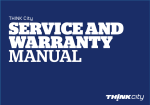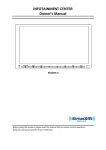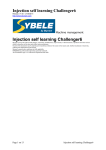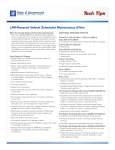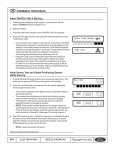Download THINK City BATTERY MANUAL
Transcript
THINK City BATTERY MANUAL EnerDel Lithium-Ion User Information — Batteries This manual is the property of THINK NORTH AMERICA, INC. (THINK NA). Reproduction by any means, electronically or mechanically, in whole or part, is not permitted without written authorization from THINK NA. Specifications, descriptions, references to official codes/ regulations, technical data and illustrations in this manual are correct information at the time of printing. Product design and product development are an ongoing process, and THINK may change the product or contents of this manual without notice and without incurring any liability or responsibility as a result. Symbols Indicates a situation in which serious bodily injury or death could result if the warning is ignored. ! CAUTION Indicates a situation in which bodily injury or damage to your vehicle, or both, could result if the caution is ignored. NOTE: Provides useful supporting information and sometimes suggests how to make better use of your vehicle. Nothing in this manual will release the owner/user of a THINK City vehicle of his or her responsibility for sensible use of the vehicle, and to follow road traffic laws and regulations, including other laws and regulations related to THINK City’s intended use. THINK City is manufactured by: THINK NORTH AMERICA, INC. 3221 Magnum Drive Elkhart, Indiana 46516 www.thinkev.com 1-1 User Information — Batteries Battery electric vehicles have certain characteristics that require unique care and attention. The THINK CITY has high voltage systems that can cause electrical shock possibly resulting in serious injury or death. Your vehicle was built with safety as a fundamental concern, but reasonable care must be exercised including: • Do not tamper with orange high voltage wiring or any component attached to such wires, and in the event of an accident, do not touch orange high voltage wiring or any component attached to such wires. • Pay attention to the warnings in this manual and to all labels in the vehicle. • Do not work on the electrical system of the vehicle and allow only qualified personnel to do such work. • Only use the charging cable supplied with the vehicle and do not use that cable if it is damaged in any way. 1-2 To ensure safety, the vehicle must only be charged from a grounded power supply. No other connection must be used. User Information — Batteries Table of Contents Safety and Important Measures..............................................................................................................................1-4 In Case of an Accident...................................................................................................................................................1-4 General.................................................................................................................................................................1-4 In Case of Fire.....................................................................................................................................................1-4 Fire Extinction..................................................................................................................................................1-4 Identification of Traction Battery...........................................................................................................................1-5 Traction Battery — Introduction..............................................................................................................................1-5 Battery Location.............................................................................................................................................................1-5 The EnerDel Lithium-Ion Battery in Use..............................................................................................................1-6 Ideal Use...............................................................................................................................................................1-6 Charging............................................................................................................................................................................. 1-7 Estimated Charging Time............................................................................................................................1-8 Troubleshooting..............................................................................................................................................1-9 When the Battery is Depleted....................................................................................................................1-9 When the Vehicle Has Been Idle For a Long Time.............................................................................1-9 Storage...............................................................................................................................................................................1-10 Specifications and Technical Data.......................................................................................................................1-10 Driving Range..................................................................................................................................................1-10 Technical Data.................................................................................................................................................1-11 Index.................................................................................................................................................................................. 1-12 1-3 User Information — Batteries Safety and Important Measures NOTE: The EnerDel lithium-ion battery is fitted in a closed case underneath the vehicle. With normal use, the battery does not generate gases. There are no high temperature surfaces and the battery case is electrically insulated. The lithium-ion battery has a separate control system to ensure safe use. The safety features are based on the following: 1. If a severe error on the battery is detected, the control system will close down all charging and discharging (use) of the battery. Electric connections between the vehicle and the battery will be disconnected. Electric isolation fault is an example of a severe error. The driver is notified by warning lights in the instrument panel (see User Manual, Chapter 2 - “Main Instrument Cluster with Warning Lamps”). 2. If the air bag is deployed, the control system will stop charging and discharging. 3. If the inertia sensor in the motor compartment is activated, for instance, in a collision, the control system will stop charging and discharging. 4. Mechanical protection; the battery is fitted in a case to prevent access to the battery components. 1-4 In Case of an Accident General First, get an overview of the situation and the accident. If possible, move the vehicle to ensure that it is not a danger to people and traffic. Call for required help (police, ambulance, fire department). Place a warning triangle on the road and put on a reflective safety vest. Provide assistance if people are injured. In Case of Fire If a fire should occur in the vehicle, keep passengers and public away from the vicinity of the fire. Make sure to move away from wind that may carry smoke. Contact fire department and police as soon as possible. Fire Extinction To extinguish fire, an ABC powder extinguisher or other type of extinguisher intended for burning metal is recommended. A CO2 extinguisher can also be used. User Information — Batteries Identification of Traction Battery You will be able to identify the traction battery in your vehicle on the label inside the charge lid. Battery Location Charge socket On your vehicle, the label will be marked: Li-Ion. This means the vehicle has a lithium-ion traction battery. Traction Battery — Introduction Your THINK City is driven by an electric motor. The motor takes power from the traction battery, which is located under the vehicle. In addition to the electric motor, the traction battery also provides power to the cabin heater, air conditioning (optional equipment) and charges the 12V battery. This 12V battery provides power to lights, dashboard, interior fan, radio/ CD player (if equipped), etc. The traction battery, or battery pack, consists of a number of single battery cells joined together to give the desired amount of energy. Battery identification label Battery type: EnerDel lithium-ion 1-5 User Information — Batteries The EnerDel Lithium-Ion Battery in Use The performance of the lithium-ion battery is influenced by ambient temperature to a certain extent. If the battery has a very low temperature, it can decrease the driving range of the vehicle. If the vehicle is not in use, THINK NA recommends that the vehicle should not be connected continuously to the external electrical power supply for more than one week, unless an additional battery cooling system is installed (optional). At long term storage, if the ambient temperature is expected to be higher than 86°F for more than 2 weeks, the state of charge (SOC)/energy level of the battery should be ideally between 40% and 60%. Such precautions may prevent reduced lifetime of the battery pack. The performance of the vehicle will stay unchanged as long as the energy level of the traction battery is over 10%. However, under certain conditions, for instance if the vehicle is driven under extreme conditions, the internal temperature of the traction battery can reach a level that causes reduction of the performance. This is a necessary measure to avoid damage to the battery. If this occurs, a warning light indicating reduced performance will be illuminated. (Power Limit- see Chapter 2 in the User Manual.) If the battery has been in storage over a long time in low temperature and with low SOC, performance may be reduced until the battery temperature has increased. 1-6 Ideal Use The ideal usage of the lithium-ion battery is when the SOC level is maintained between 20-80%. This way the best possible battery performance and lifetime can be ensured. User Information — Batteries Charging Charging the traction battery is easy and safe. Use the charging cable that was supplied with the vehicle to charge the battery. As the lithium-ion battery is influenced, to a certain extent, by temperature, it is recommended to charge the battery in an ambient temperature of 50-77°F, if possible. The temperature can influence the level to which the battery can be charged. The charging rate can be reduced at freezing temperatures. Please refer to the User Manual and the Portable Charger System Booklet of the vehicle for more information about the charging cable, charging and troubleshooting. Battery electric vehicles have certain characteristics that require unique care and attention. The THINK CITY has high voltage systems that can cause electrical shock possibly resulting in serious injury or death. Your vehicle was built with safety as a fundamental concern, but reasonable care must be exercised including: • Do not tamper with orange high voltage wiring or any component attached to such wires, and in the event of an accident, do not touch orange high voltage wiring or any component attached to such wires. • Pay attention to the warnings in this manual and to all labels in the vehicle. • Do not work on the electrical system of the vehicle and allow only qualified personnel to do such work. • Only use the charging cable supplied with the vehicle and do not use that cable if it is damaged in any way. Charge Indicator (on top of instrument cluster) Illuminated when charge in progress Illuminated when charging cable is connected 1-7 User Information — Batteries Estimated Charging Time Estimated charging times for the lithium-ion battery from a 15 A / 240V main outlet: Energy level 0 - 100 %: approximately 8 hours. Estimate 25% longer charging time when using a 10 A main outlet. Low energy level 100 90 80 State of Charge (SOC), % Energy indicator. Indicates the energy level of the battery in percent (SOC – State of Charge). 70 60 50 10 A 15 A 40 30 20 Warning light for low battery level. Steady light indicates that the battery charge level is under 10%. At 0% charge level, the light will be flashing to indicate depleted battery. 10 0 2 4 6 Time, hours 8 10 Estimated charging time for EnerDel battery at room temperature 1-8 12 User Information — Batteries Troubleshooting If the battery charging is not completed within the expected time, examine the following possible causes: • The battery is too cold, i.e., if the internal temperature of the battery is below -13˚F, it cannot be charged. Wait until the temperature has risen or if possible, move the vehicle indoors before charging. NOTE: At very low temperatures, the battery cannot be completely charged. • The charging cable can be defective or not connected completely. • The gearshift lever is not in P (PARK), which prevents charging. • Isolation fault in the battery (or other battery faults) will prevent the charging process from starting. If this happens, contact a THINK-authorized workshop. • The 12V battery is depleted or has a very low energy level. The traction battery cannot be charged when the 12V battery has a voltage lower than 10V. In such cases, the 12V battery needs to be charged first. Refer to Chapter 5 in the vehicle User Manual for more information about charging the 12V battery. • The fuse of the household main outlet is blown. When these possibilities have been eliminated, connect the vehicle to the power supply to complete the charging process. There is important information to be read in Chapter 1 “Get to Know Your THINK City” in the User Manual on troubleshooting the charging cable. Alternatively, contact your THINK NA dealer. When the Battery is Depleted If the traction battery is totally depleted, it is necessary to charge it before using the vehicle. Verify that sufficient charge level has been obtained before driving the vehicle. If not, you have to wait until the battery has enough energy. When the Vehicle Has Been Idle For a Long Time Even if the vehicle has been idle for a long time (over a month), it is not likely that the traction battery is completely depleted. It is more likely that the 12V battery is depleted or has such a low energy level that the vehicle cannot be started or the main battery cannot be charged. If the 12V battery has a voltage lower than 10V, it needs to be charged. Refer to Chapter 5 in the User Manual for more information about this. 1-9 User Information — Batteries Specifications and Technical Data Driving Range Your THINK City has an estimated driving range of about 100 miles (160 km). Use of the 12V outlet (for cell phone charging or GPS, for example), cabin heater, winter tires, driving in mountainous areas or with roof carrier, etc. reduces the driving range. Refer to Chapter 4 in the User Manual for more information about economical driving. 100 % of maximum nominal range Storage When the vehicle is kept in storage for a longer period (2 weeks or more), the following precautions are recommended: • Ensure that the traction battery has an energy level between 40-60%. • Disconnect the vehicle from the electrical outlet by disconnecting the charging cable. Long-time continuous electrical connection in warm climates is only recommended if there is an extra cooling system installed in the vehicle (optional). • Disconnect the 12V battery or connect a maintenance charger on the 12V battery to keep it fully charged. NOTE: It is recommended that the battery charging cable is disconnected from the vehicle first and then from the electrical outlet. 90 80 70 The driving range of your THINK City depends not only on the outside temperature, but also on driving behavior, usage of cabin heater, winter tires, roof carriers, city or highway driving, etc. In general, a warm battery will have better driving range, i.e. a lot of short distance drives will give shorter range than one long drive. 60 50 40 30 20 10 0 –30 –20 –10 0 10 20 30 Ambient temperature °C 40 50 Relationship between ambient temperature and “city driving range” for EnerDel battery* 1-10 User Information — Batteries Technical Data Brand: EnerDel lithium-ion Voltage: 400 VDC Stored power/capacity: 23,0 kWh / 70 Ah Weight: 630 lb Self discharge level: Ca. 4 W Charging time: 0 - 100% approximately 8 hours Above estimate is valid when charging from a 15 A /240V main outlet at above 60° F (15 °C) ambient temperature. Estimate 25% more charging time when using a 10 A main outlet. Charging voltage: 120V / 60 Hz or 240V / 60 Hz (Preferred) Charging current: 10 A / 15 A 1-11 User Information — Batteries Index Entry: Page: Battery location 1-5 Battery type 1-5 Charge socket 1-5 Charging 1-2, 1-4, 1-7, 1-8, 1-10, 1-11 Charging time 1-8, 1-10 EnerDel lithium-ion battery 1-4, 1-6 Energy indicator 1-8 Energy level 1-8 Ideal use 1-6 Specifications 1-10 Storage 1-10 Technical data 1-11 Traction battery 1-5 Troubleshooting 1-9 Driving range 1-10 1-12 THINK NORTH AMERICA, INC. 3221 Magnum Drive Elkhart, Indiana 46516 www.thinkev.com ©2010 THINK NORTH AMERICA, INC. Version 1 • November 2010 • 575.1280.A Distributor:
















